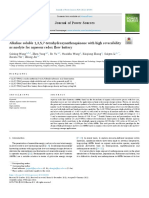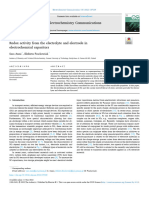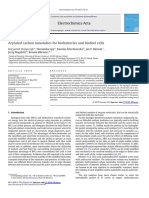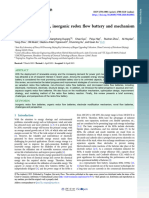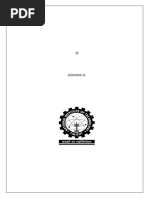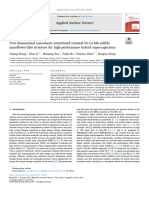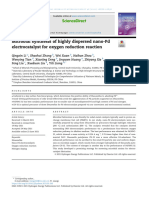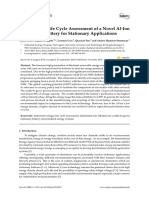Organic Redox Species in Aqueous Flow Batteries: Redox Potentials, Chemical Stability and Solubility
Organic Redox Species in Aqueous Flow Batteries: Redox Potentials, Chemical Stability and Solubility
Uploaded by
Anonymous P7J7V4Copyright:
Available Formats
Organic Redox Species in Aqueous Flow Batteries: Redox Potentials, Chemical Stability and Solubility
Organic Redox Species in Aqueous Flow Batteries: Redox Potentials, Chemical Stability and Solubility
Uploaded by
Anonymous P7J7V4Original Title
Copyright
Available Formats
Share this document
Did you find this document useful?
Is this content inappropriate?
Copyright:
Available Formats
Organic Redox Species in Aqueous Flow Batteries: Redox Potentials, Chemical Stability and Solubility
Organic Redox Species in Aqueous Flow Batteries: Redox Potentials, Chemical Stability and Solubility
Uploaded by
Anonymous P7J7V4Copyright:
Available Formats
www.nature.
com/scientificreports
OPEN Organic Redox Species in Aqueous
Flow Batteries: Redox Potentials,
Chemical Stability and Solubility
received: 22 August 2016 Kristina Wedege1, Emil Dražević1, Denes Konya2 & Anders Bentien1
accepted: 01 November 2016
Published: 14 December 2016
Organic molecules are currently investigated as redox species for aqueous low-cost redox flow batteries
(RFBs). The envisioned features of using organic redox species are low cost and increased flexibility
with respect to tailoring redox potential and solubility from molecular engineering of side groups on
the organic redox-active species. In this paper 33, mainly quinone-based, compounds are studied
experimentially in terms of pH dependent redox potential, solubility and stability, combined with single
cell battery RFB tests on selected redox pairs. Data shows that both the solubility and redox potential
are determined by the position of the side groups and only to a small extent by the number of side
groups. Additionally, the chemical stability and possible degradation mechanisms leading to capacity
loss over time are discussed. The main challenge for the development of all-organic RFBs is to identify a
redox pair for the positive side with sufficiently high stability and redox potential that enables battery
cell potentials above 1 V.
The widespread interest in replacing fossil fuels with renewable energy sources is a challenging task motivated by
a need for energy independence and carbon footprint reduction. The cost of wind and photovoltaics electricity is
still decreasing and will be integrated even more in a future fully renewable-based utility grid. However, this inte-
gration is faced with major challenges with respect to stability and security of supply because of the mismatch
between electricity production and demand1. This can to some extent be solved by expansion of the transmission
grid, intelligent demand-response schemes and storage/use of surplus electricity with heat pumps in reservoirs or
pumped hydro2–5. Nonetheless, there will be a need for local/regional electricity storage5. Here batteries, which
already are applied in the utility grid, are an obvious solution. However, a broader market penetration is critically
dependent on the cost, which can be quantified by the levelized cost of electricity storage (LCES)6,7. In the simplest
form it is given by LCES [$kWh−1cycle−1] = CC [$kWh−1]/(N ⋅ η), where LCES expresses the cost of storing and
discharging one kWh in a cycle, CC are the capital costs per kWh, N the number of cycles during lifetime and η is
the cycle efficiency8. Here capital cost in the range $120-$150 kWh−1 and a LCES of less than ¢10 kWh−1 cycle−1
is generally considered a breakthrough in energy storage9,10.
Recently, organic aqueous flow batteries have been proposed as a low-cost alternative to the present
metal-based RFB technology11–14. Additionally, it is envisioned that the redox potential and solubility can be
tailored by introduction of specific side groups on the organic redox-active species. The maximum allowable cost
of organic redox species was studied in a scenario where a system capital cost for an aqueous RFB of $120 kWh−1
was targeted9. With moderately optimistic assumptions of $300 kW−1 for balance-of-plant/profit and flow cell
cost normalised to internal resistance of 5 $ mΩ, it was shown that cell potentials of 1 V and 1.5 V result in a
maximum acceptable costs of redox species of $4 kg−1 ($15 kAh−1) and $7 kg−1 ($26 kAh−1) respectively9. An
interesting point here is that the redox species maximum allowable cost scales with the cell potential with a power
greater than one. This is because not only the energy density increases with cell potential, but also cycle efficiency
for a given internal flow cell resistance. Cost limits in the range $4 kg−1 ($15 kAh−1) and $7 kg−1 ($26 kAh−1) for
organic redox species are not unrealistic. The base chemical cost for e.g. benzene is around $1.2 kg−1 while the
cost of unsubstituted anthraquinone is $10–15 kAh−1 (see Supplementary, S9).
Figure 1 outlines an all-organic RFB13. It is based on 4,5-dihydroxy-1,3-benzenedisulfonate (HQ(1,2)DS) on
the positive side (container A) and anthraquinone-2-sulfonate (AQ(2)S) on the negative (container B). During
charging/discharging, two electrons are exchanged through an external circuit as HQ(1,2)DS and AQ(2)S is
1
Department of Engineering - Aarhus University, Hangøvej, 2,8200 Aarhus N, Denmark. 2Research Centre for Natural
Sciences, Magyar tudósok körútja 2, 1117 Budapest, Hungary. Correspondence and requests for materials should be
addressed to E.D. (email: edrazevic@eng.au.dk) or A.B. (email: bentien@eng.au.dk)
Scientific Reports | 6:39101 | DOI: 10.1038/srep39101 1
www.nature.com/scientificreports/
Figure 1. Schematic of an all-quinone RFB during charging13. Quinone species are dissolved in 1 M H2SO4,
and the cell potential is 0.7 V. During charging each quinone stores 2 electrons while at the same time 2 H+ are
exchanged through Nafion.
reduced and oxidized and two protons are exchanged through a Nafion membrane. It shows high coulombic
efficiency, however the cell voltage is merely 0.7 V and significant capacity loss was observed due to chemical
instability of the sulfonated hydroquinone13,15. Two other all-organic, radical based RFBs were recently demon-
strated with a cell potential of 1.25 V14,16. They employ the organic radical TEMPOL (4-hydroxy-TEMPO) on the
positive side and viologen on the negative side. In one of the studies, TEMPOL and viologen are bonded to water
soluble polymers, which allows the use of a cheap Celgard separator14. However, at higher concentrations both
systems lose capacity after only 100 cycles.
In addition to all-organic systems, RFBs that employ organics only on one side have been studied11,12. Here
anthraquinone-2,7-disulfonic acid (AQDS(2,7)) and bromine in an acidic environment result in a cell voltage of
0.9 V, while 2,6-dihydroxy anthraquinone (AQDH(2,6)) and potassium ferricyanide in an alkaline environment
results in a cell potential of 1.2 V11,12. A similar more recent advance is the use of an alloxazine-based (i.e. a vita-
min B analogue) anolyte with ferrocyanide in an alkaline environment also producing a cell voltage of 1.2 V and
high capacity retention17. Although discharge current densities in these RFBs are almost twice those observed for
optimised vanadium RFBs, the maximum discharge power densities are about the same (0.4–0.6 W cm−2) because
of the lower cell potentials18.
The possibility of tuning the solubility and redox potentials through substitutions of the side groups has
recently been explored for quinones with density functional theory (DFT) calculations19,20. The results show that
all-quinone aqueous RFBs with cell potential above 1.0 V is attainable by addition of electron withdrawing groups
on hydroquinones and electron donating groups on anthraquinones.
However, so far there have been no systematic experimental studies of the actual change in redox potential and
solubility with different functionalization. In the present study, we have experimentally determined redox poten-
tials and aqueous solubility of 28 different benzo/hydroquinones (BQs), naphtoquinones (NQs) and anthraqui-
nones (AQs) in acidic, neutral and alkaline solutions along with a few nitrogen based redox species. We discuss
the limitations of their properties with respect to RFB performance and discuss some of the main challenges with
respect to realising all-organic RFBs.
Experimental Methods
Figure 2 shows the structures of tested organic compounds as well as their abbreviations. In this work the deno-
tation anthraquinone (AQ) is strictly the 9,10 isomer.
Cyclic voltammetry studies. The investigated compounds were used as-purchased and without any puri-
fication. Supplier data and purity are found in Supplementary, S4. Cyclic voltammograms (CVs) were recorded
with a Chemical Instruments potentiostat (CHI660E) using a standard three-electrode configuration consisting
of a 3 M KCl Ag/AgCl reference electrode (+0.210 VNHE) (CHI111), a platinum wire counter electrode (CHI115)
and a homemade circular 1 mm glassy carbon (GC) electrode prepared as reported elsewhere21. For each series
of CVs, a freshly polished electrode was used. The CVs for soluble compounds in 1 mM concentration were
recorded in a glass beaker with a customized lid in nitrogen purged solutions of three different pHs, namely pH 0
(1 M H2SO4), pH 7 (0.5 M phosphate buffer) and pH 13 (1 M NaOH). The pH of the NaOH solution is taken as
13 to account for carbonization of the solution with exposure to air. A background CV was recorded before each
CV experiment to exclude background contaminations. The CVs of insoluble compounds in 1 M H2SO4, or 0.5 M
phosphate buffer were recorded as follows: 6 mL of the supporting electrolyte was mixed with approximately 4 mL
of acetone, and then a small amount of the quinone was added so that its concentration was around 1 mM. When
the concentration of water in the mixture with organic solvent is greater than 7.2 M (here it was around 30 M)
the separation between first and second reduction peak becomes 0 V22. This procedure gives a fair estimate of
the redox potential of the quinone at pHs where it is insoluble in water. All CVs are found in Supplementary, S6.
Scientific Reports | 6:39101 | DOI: 10.1038/srep39101 2
www.nature.com/scientificreports/
Figure 2. Structures and abbreviations of organic species. BQ = benzoquinone, HQ = hydroquinone,
NQ = naphtoquinone and AQ = anthraquinone.
CV analysis. Each CV was analyzed in terms of peak potentials and peak currents. Peak currents were
determined by subtracting a polynomial fit of the background from the recorded current as exemplified in
Supplementary, S1. A plot of the absolute values of the peak currents to the square root of the scan rate was con-
structed and, when reasonable, a linear fit included to evaluate the electrochemical (Nernstian) reversibility of the
electrochemical reaction. The peak current Ip for reversible reactions are given by equation (1) 23.
I p = 0.446 ⋅ (F 3 ⋅ (RT )−1)1/2 ⋅ n3/2A ⋅ DO1/2 ⋅ CO⁎ ⋅ v 1/2 (1)
Scientific Reports | 6:39101 | DOI: 10.1038/srep39101 3
www.nature.com/scientificreports/
Figure 3. General quinone reduction at low pH (left) and scheme-of-squares for AQ-2,6-disulfonate and
AQS(2) (right). Horizontal movement indicates electron transfer and vertical indicates proton transfer. They
are guided by the redox potentials and pKa values of the quinone groups. Adapted from Batchelor et al.26.
Where F is the Faraday constant, R the gas constant, T the temperature, n the number of electron transferred, A
the area of the electrode, DO the diffusion coefficient and CO* the bulk concentration of the analyte and v the scan
rate. The peak current ratio is expected to be close to one for reversible species. The formal redox potential (E0’),
which is the adjusted form of the standard redox potential, where effects of the medium is taken into account,
is reported here as the midpoint potential between the two peak potentials in the CV24. All half-cell potentials
in this work refer to the normal hydrogen electrode (VNHE). All derived CV and solubility data are found in
Supplementary, S4 and S5.
RFB tests. A single 25 cm2 cell with carbon felt electrodes, graphite bipolar plates, copper current collectors
and Nafion-117 ion exchange membrane was used. Prior to all battery tests the solutions were purged with nitro-
gen for 10 min and the tests were performed at room temperature. Carbon felt electrodes (4 mm thick, Sigracell)
were pre-treated for one hour at 80 °C in H2SO4/HNO3 mixture (3:1 volumetric ratio) and then they were thor-
oughly washed with demineralized water. Nafion-117 was pre-treated in a following way: i) boiled for 30 min in
3% H2O2 aqueous solution, ii) washed with milliQ water and iii) left for one hour in 1 M H2SO4, phosphate buffer
or KOH, depending on the pH value of the solution during RFB test. To assemble the cell, current collectors
were screwed together by 6–11 bolts with bipolar plates, electrodes and Teflon + silicon gaskets in between. Two
Grundfos DDA pumps circulated the electrolyte at a flow rate of 100 mL/min using Teflon tubing. The current
was maintained constant at +/−200 mA during tests using a Neware Battery Testing System CT-3008-5V3A-S1
(Shenzhen, China).
Aqueous solubility estimation. Aqueous solubility (OECD test #105) was estimated in 1 M H2SO4, 1 M KCl
and 1 M KOH prepared from MilliQ water25. Around 0.10 g of the pulverized compound was transferred to a glass
tube after which increasing volumes of the supporting electrolyte solution was added in intervals of 10–100 μL
depending on the expected solubility. After each addition the test tube was ultrasonicated and/or shaken vigor-
ously using a Vortex Generator for at least 10 minutes at room temperature. Then the tube was inspected visually
for undissolved sample and the addition of supporting electrolyte solution continued until the sample seemed
just dissolved. The volumes just before and after full dissolution are used for calculating the solubility interval
(Supplementary, S4 and S5) and the solubility is estimated as the average between the two. Addition of water
was terminated when the solubility of the compound was less than 10 mM. Dissolved samples were left to stand
for 12 hours and visually inspected for thixotropy using a vortex generator. For very insoluble compounds the
amount of sample was decreased to 0.01 g and the dissolution time increased up to 24 h.
Results and Discussion
The electrochemical reaction of quinones in aqueous media. Quinones generally undergo a revers-
ible two-electron reduction/oxidation. The redox potential is strongly pH dependent, as the reaction may or may
not involve two protons as illustrated in the scheme-of-squares mechanistic pathway in Fig. 3 26. At pH < pKa1, the
reaction includes two protons and thus E0’ decreases with 59 mV per pH unit (at 25 °C)24. At pKa1 < pH < pKa2
and pKa2 < pH only one and no protons are involved, whereby E0’ decreases with 30 and 0 mV per pH unit,
respectively. Generally, the reactions that include protons are slower and result in a lower electrochemical rate
constant (k0) and may ultimately lead to higher charge-transfer resistance in the RFB. Thus, the choice of pH in
the RFB environment strongly influences quinone electrochemical performance.
E0’ of anthraquinone derivatives. Figure 4 shows the experimental E0’ at three different pH values for all qui-
nones in the study. Figure 5 shows a more detailed Pourbaix diagrams of selected AQ species, where it is seen
that E0’ of unsubstituted AQ is about 300 mV lower than that of HQ(1,4) at pH 0. This illustrates that AQs are
Scientific Reports | 6:39101 | DOI: 10.1038/srep39101 4
www.nature.com/scientificreports/
Figure 4. Formal standard potential determined from CV analysis at three different pH values for the
tested quinones divided by group functionality. Crosses indicate literature values11–13,26–27. AQs are found to
the left with the sulfonated on top and the hydroxylated in the bottom, while BQs and NQs are found to the
right in the top and bottom, respectively. Numbering sequence of the substitution sites are indicated in the
structures in the figure.
Figure 5. Pourbaix diagram for some AQ derivatives and pure AQ (Supplementary, S2) and input of lines
with slopes −59 mV/pH unit for two-proton transfer and −30 mV/pH unit for one-proton transfer. All
black marks refer to data from this report, while grey boxes refers to already published data11.
inherently electron rich species with redox potentials that are generally lower than those of the BQs, because
unsubstituted AQ is in fact a BQ substituted with two benzene groups. In a recent DFT studies on a large ensam-
ple of quinones with various functional groups, it was found that it should be possible to change the stand-
ard redox potential from as high as 0.6 VNHE to −1.5 VNHE19,20. Functional groups such as halogens, sulfonate or
carboxyl groups were considered as electron withdrawing groups (EWGs) and hydroxyl and methyl groups as
electron donating groups (EDGs). In this sense, higher redox potential would be expected for AQs with EWDs
such as sulfonated AQs and lower for hydroxylated due to electron donation/withdrawal19. Nonetheless, the
experimental data presented in Fig. 4 does not reproduce the full impact of this trend. It is seen that for sul-
fonated AQs, E0’ is only about 200 mV–300 mV higher than that of hydroxylated ones. Additionally, the position
of sulfonate groups is very important, while the number seems to have very little effect. For instance, the two
Scientific Reports | 6:39101 | DOI: 10.1038/srep39101 5
www.nature.com/scientificreports/
sulfonate groups in the edge positions in AQDS(2,7) decrease E0’ compared to the parent AQ from + 0.4 VNHE,pH=0
to + 0.165 VNHE,pH=0. Almost the same effect on E0’ is observed with only one sulfonate group in AQS(2), which
has E0’ of + 0.163 VNHE,pH=0, indicating that sulfonate groups behave as EDGs by decreasing the potential, not
as EWGs as expected. Changing only the positions of the sulfonate groups lowers the potential even further,
by about 400 mV to + 0.03 VNHE,pH=0 for AQDS(1,8) and −0.03 VNHE,pH=0 for AQDS(1,5). This leads to the con-
clusion that when substituting with sulfonate groups, there is a higher electron donating effect in positions 1, 5
and 8 close to the quinone groups, while it is less pronounced in edge positions 2,7. This is also the case for edge
position 6, as E0’ for AQDS(2,6) is around +0.166 VNHE,pH=026.
Addition of two hydroxyl groups to the mono-sulfonated AQS(2) to give AQS(2)DH lowers E0’ to
+0 .015 VNHE,pH=0 indicating that the electron donating effect of hydroxyl groups is larger than that of one sulfonate
group and similar to sulfonate group substitution closer to the quinone. Addition of one bromo and one amino
group on the mono-sulfonated AQ to AQS(2)NBr lowers E0’ by only 20 mV at pH 0 indicating very small overall
effect by these groups.
E0’ for the hydroxylated AQs is around 0 VNHE,pH=0, −0.4 VNHE,pH=7 and −0.6 VNHE,pH=13 and the variation is
limited. Compared to E0’ of unsubstituted AQ of + 0.4 VNHE,pH=0, 0 VNHE,pH=7 and an estimated −0.4 VNHE,pH=13 (by
extrapolation in Fig. 5), the electron donating effect of hydroxyl groups on AQ decreases E0’ by 200 mV–400 mV
depending on pH. Again the experimental data here does not reproduce the large effect on E0’ expected from
theoretical calculations. Addition of more hydroxyl groups does not lower the potential significantly, though the
number of hydroxyl groups slightly affects E0’ in alkaline, which agrees well with DFT calculations19. For example,
the tetrahydroxylated AQTH(1,4) has approximately 100 mV more negative E0’ compared to AQDH(1,4), but
none have more negative E0’ than AQDH(2,6) at −0.70 VNHE,pH=13. AQDH(1,2) has an E0’ of −0.67 VNHE,pH=13,
very similar to AQDH(2,6) indicating the importance of having a hydroxyl group in an edge position in order to
reach the most negative potential. It is quite similar to AQTrH M which has three hydroxyl groups on the AQ (one
edge group) and a methyl group on the edge giving E0’ of −0.69 VNHE,pH=13.
Similarly to sulfonated AQs, the positions of the hydroxyl groups affect E0’, but in acidic only to a small extent.
Comparing dihydroxylated AQs, the two hydroxyl groups in AQDH(2,6) gives the most positive potential, of
+0.04 VNHE,pH=0 while AQDH(1,5) and AQDH(1,8) is most negative (just below 0 VNHE,pH=0). In alkaline, E0’ of
the hydroxylated AQs varies much more with position, by 200 mV from about −0.50 VNHE,pH=13 for AQDH(1,4),
AQDH(1,8) and AQDH(1,5) to −0.70 VNHE,pH=13 for AQDH(2,6). The three former all have the hydroxyl groups
on positions close to the quinone groups. The difference in E0’ for these hydroxylated AQs and others may be
found in the pKa values of the central (hydro)quinone groups. Those are not trivial to measure given the insolu-
bility at lower pH values for hydroxylated AQs, but they can be estimated from the Pourbaix diagram in Fig. 5 24,26.
For instance, in the Pourbaix diagram of AQDS(2,7), E0’ follows the expected −59 mv/pH unit from pH 0 to pH 7
(pKa1). Then the first (hydro)quinone group deprotonates, and the slope changes to 30 mV/pH unit until pH 10
(pKa2) and E0’ becomes pH-independent. AQDH(1,8) shows a different dependence, where pKa1 is somewhere
around pH 4 and pKa2 above pH 13. AQDH(2,6) shows an even more different behaviour as E0’ follows −5 9 mV/
pH unit dependence straight to pH 13, which implies that both pKa values are higher than 13. The difference in
protonation behaviour explains the observed more negative E0’ for AQDH(2,6) compared to AQDH(1,8) since
it is only at higher pH than pKa1 of AQDH(1,8) around pH 4 that E0’ deviates between the compounds. Thus, if
one can predict or measure reasonable values for these pKa values, it should be possible to predict which ones will
have a more negative or positive E0’ at higher pH.
Taken together, it thus appears that the magnitude of the negative potentials that can be reached by hydroxyl
group substitution is limited to about −0.7 VNHE,pH=13 and redox potentials below −1 VNHE,pH=13 appear unlikely.
This is in good agreement with experimentally obtained E0’ of around −0.7 VNHE,pH=13 for hexahydroxy anth-
raquinone27. Irrespective of pH, EWGs placed on the edge of the dihydroxylated AQ do not alter E0’. This can
be seen by comparing AQDH(4,5)CA with other AQDHs which have hydroxyl groups in similar positions. E0’
of AQDH(4,5)CA is around −0.53 VNHE,pH=13, which is similar to the other dihydroxylated AQs with hydroxyl
groups in positions close to the quinone groups. Additionally, AQS(2)DH has both a hydroxyl and a sulfonate
group in edge positions, and E0’ of +0.07 VNHE,pH=0 and −0.69 VNHE,pH=13, very close to that of AQDH(2,6). It
virtually behaves as there is no EWG group.
E0’ of naphtoquinone and benzoquinone derivatives. Of the tested naphthoquinones, NQ(1,2)S show the high-
est E0’ of +0.6 VNHE,pH=0. The halogenated and hydroxylated NQ(1,4)DHDCl are electrochemically irreversible.
Interestingly, the addition of one hydroxyl group in the case of NQ(1,4)H and NQ(1,4)HB shifts E0’ in alkaline
by 0.8 V, to around −0.5 VNHE,pH=13, which gives a slope of 67 mV/pH unit. This is higher than observed for AQs,
and lower than BQs, as will be described later. The potentials of NQs in alkaline are sufficiently negative for use as
anolyte, provided sufficient solubility and stability can be reached.
It can be seen from Fig. 4 that ortho-BQs in general have an E0’ almost 100 mV higher compared to para-BQs.
The most interesting results are the effect of substituting these two parent BQs with EWGs, and its implication
on chemical stability. Although DFT calculations suggest that sulfonate group substitution on para-BQ should
change E0’ by +100 mV, such an electron withdrawing effect was not observed experimentally as seen from
HQ(1,4) and HQ(1,4)S where the opposite tendency is seen19. Similarly, the two sulfonate groups on ortho-BQ
in HQ(1,2)DS increases E0’ by only +50 mV, which is less than predicted. The halogens, e.g. four fluoro or chloro
groups (EWGs) on HQ(1,4)TC and HQ(1,4)TF show very small effect on the potential, which is in good agree-
ment with the DFT calculations19. However, halogen substituents are prone to the nucleophilic attack of/in
water and substitution reactions28. This can be verified by comparing the chemically irreversible CVs at pH 13
(Supplementary, S6, Figs 31 and 33). Chemical instability in water has also been reported for other benzoqui-
nones, e.g. tetracyano benzoquinone29. E0’ was estimated to be +0.3 V higher than that of dicyano dichloro ben-
zoquinone, which has E0´ of 0.9 VNHE, and also readily reacts with water30. Another example of a high-potential
Scientific Reports | 6:39101 | DOI: 10.1038/srep39101 6
www.nature.com/scientificreports/
but very reactive benzoquinone is tetracarboxyl para benzoquinone which decomposes after synthesis and has a
calculated standard potential of above +1 VNHE19,31. From the BQ CVs (Supplementary, Figures 25–33) they all
generally appear (electro)chemically unstable in water.
Hydroxylation and methylation should affect E0’ towards more negative values19. Two hydroxyl groups on
HQ(1,4)DH reduce E0’ by 300 mV at pH 0 compared to the parent BQ compound. Further reduction of E0 by sub-
stitution with more hydroxyl groups lowers the electrochemical reversibility. This is exemplified by BQ(1,4)TH
which completely loses its electrochemical activity (Supplementary, S6, Figure 32). Other EDGs do not cause this
instability, as BQ substituted with four methyl groups (duroquinone) has been reported to remain electrochem-
ically reversible and chemically stable, with a potential of 0.5 VNHE in aqueous (acidic and neutral) solutions32.
Many methylated and alkylated BQs are natural compounds, i.e. Coenzyme Q10 (ubiquinone), duroquinone or
plastoquinone. Generally, it appears that fully methyl and alkyl group substituted BQs are chemically stable in
water, but this comes at the cost of a low E0’ and very low solubility.
Perhaps the most interesting effect from hydroxyl groups on BQs is their effect on the pH dependence of E0’.
With just two hydroxyl groups in BQ(1,4)DH, E0’ changes from +0.38 VNHE,pH=0 to −0.73 VNHE,pH=13 correspond-
ing to almost −90 mV/pH unit change. For para-BQ it changes from +0.70 VNHE,pH=0 to +0.11 VNHE,pH=13, and is
only half (−45 mV/pH unit). This suggests that one of the two hydroxyl substituents also protonates/deprotonates
in the electrochemical reaction adding around −30 mV/pH unit to the −59 mV/pH unit ending up at the total of
−90 mV/pH unit. A similar effect is observed for BQ(1,4)DHDCl where the potential changes by 0.99 V for 13 pH
units, which corresponds to −76 mV/pH unit. Both species have large negative E0’ in alkaline, −0.73 VNHE,pH=13
for the former and −0.60 VNHE,pH=13, for the latter. This suggests that E0’ is more affected by the pH of the sup-
porting electrolyte than expected. To our knowledge this has not been described or explained in literature and it
leads to the surprising conclusion that the E0’ of BQs are in the range, and in some cases even more negative than
of those of AQs in alkaline. This could make them possible to use as anolytes in alkaline, provided it is possible to
achieve fair aqueous solubility and in particular chemical stability.
Chemical stability of organics in RFBs. The chemical stability of redox couples in RFBs is very impor-
tant, since low life-time leads to impractical systems and increased LCES. By introducing organic molecules
in high concentrations in oxidative/reductive environments, the possibility of (electro)chemical side reactions
increases compared to state-of-the-art inorganic RFBs.
Figure 6 shows single cell flow battery tests of selected organic redox species mainly illustrating the challenges
associated with stability of smaller, unsubstituted quinones. In Fig. 6a and b, a hydroxylated and sulfonated NQ
are used on the negative side and fast, gradual capacity loss is seen. In Fig. 6c and d two possibilities for a small
organic species for the positive side is tested and here capacity loss is observed after a small number of cycles.
Generally, capacity loss in flow batteries can be attributed to redox species crossover through the membrane, oxi-
dation from the outside environment and chemical degradation of redox species. Here major external oxidation
is not likely since sealed and purged containers are used. Furthermore, a dense and highly selective Nafion mem-
brane was used in all RFB tests displayed in Fig. 6 and crossover has been shown to be unlikely for the relatively
large quinone molecules (HQ(1,2)DS, AQDS(2,7) and AQDH(2,6))11,12,15. For this reason we attribute the capac-
ity loss to chemical degradation of the organic redox species. The interpretation is substantiated by considering
the CVs of e.g. HQ(1,2)DS and HQ(1,4)S. At all pH values they show significantly low reduction/oxidation peak
ratio, which indicate a fast side-reaction that follows the electrochemical oxidation (Supplementary, S6, Figure 25
and 28) and creates non-electroactive species. According to recent work, HQ(1,2)DS transforms to the tri- and
tetrahydroxylated versions shortly after the oxidation to the quinone form, since water performs a Michael addi-
tion (1,4 to the α-βunsaturated carbonyl compound) as exemplified in Fig. 7a 15.
The multi-hydroxylated quinones are usually found to be electrochemically irreversible and/or insoluble. In
the case of increasing the pH, a stronger nucleophile (OH−) is predominant and thus the reduction/oxidation
peak ratio is even smaller than in acidic and neutral solution. This is confirmed further in an RFB battery tests in
Fig. 6c, where an acidic all-organic RFB with HQ(1,4)S loses half of its capacity after only 30 cycles.
NQ(1,4)H has a E0’ of −0.5 VNHE,pH=13 and seemingly reversible CV (Supplementary, S6, Figure 13) in addi-
tion to being soluble in 1 M KOH making it is a fairly good anolyte candidate. However, RFB test shows significant
capacity loss over time (Fig. 6a). Possible side-reactions includes a Michael-like conjugated addition of hydroxyl
as in Fig. 7a for the sulfonated benzoquinone on the unsubstituted position (3), while the rest are protected by
the benzene ring. In addition, an oxygen-sensitive possibility can be identified from the literature being the epox-
idation with the hydroperoxide anion33. Epoxidation is usually followed by a nucleophilic attack here creating a
non-aromatic and electrochemically irreversible hydroxylated species (Fig. 7b)34:
In practical RFB setups, there is always a risk of contamination with small amounts of oxygen which in the
case of hydroquinones creates extremely reactive superoxides and usually hydrogen peroxide. Hydrogen perox-
ide, and the hydrogen peroxide anion created from it in alkaline solutions, are even better nucleophiles than the
hydroxide ion itself. In addition, superoxides can oxidize a range of substituents and side groups. The formation
is described in Fig. 7c.
Another example is an RFB test with NQ(1,2)S shown in Fig. 6b that also suffers from significant capacity loss.
Here data indicates that the degradation process involves formation of a new redox active species giving a cell
voltage of 0.9 V with ferrocyanide as seen from the main panel. This corresponds to the NQ compound having
transformed to an electroactive hydroxylated form. Two possibilities can be readily identified, namely the addi-
tion of a hydroxyl group in position 3 in a Michael-like conjugated addition as earlier described in Fig. 7a or a
nucleophilic substitution as that suggested in Fig. 7d 35. This reaction indicates how OH− is a stronger nucleophile
than water as its conjugate base pair and is able to substitute the usually bad leaving group sulfonate (see Fig. 7a
for comparison in acidic media). The following capacity loss is then explained as in the case of NQ(1,4)H by fur-
ther hydroxylation to electrochemically inactive species.
Scientific Reports | 6:39101 | DOI: 10.1038/srep39101 7
www.nature.com/scientificreports/
Figure 6. RFB tests. (a) Current and voltage characteristics versus time for a RFB with 200 mM solutions in
1 M KOH of NQ(1,4)H on the negative side and excess ferrocyanide on the positive side. There is significant
capacity loss after only two cycles. (b) Capacity versus voltage curves for an RFB with 200 mM NQ(1,2)S and
excess ferrocyanide in 1 M KOH. The inset shows the capacity (green for charging and red for discharging) and
coulombic efficiency (blue) and significant capacity loss over 90 cycles. (c) Capacity and coulombic efficiency
over time for an RFB comprised of 50 mM HQ(1,4)H and excess AQDS(2,7) in 1 M H2SO4. The inset shows
current and voltage characteristics over time for the first eleven cycles. (d) Capacity and coulombic efficiency
over time for an RFB comprised of 50 mM solutions of TEMPOL and AQDS(2,7) in 0.5 M phosphate buffer
at pH 7 on the positive and negative side, respectively, for 24 cycles. The inset shows current and voltage
characteristics over time for the first five cycles.
Obviously, there are stability issues with organic redox species and in particular with partially substituted
quinones (NQs and BQs). The quinone contains a ketone functional group and a carbon-carbon double bond
next to it (α,βunsaturated ketone). Because of the electron withdrawing property of the ketone, this double
bond is prone to react with nucleophiles, while hydroquinone is a phenol derivative (aromatic) so because of the
structural differences of these two compounds, they behave differently. Generally, small aromatic rings (e.g. the
hydroquinone) are nucleophilic, so they are prone to react with electrophiles34. There is a difference in reactivity
between the charged and discharged species: the phenolate form – as a conjugate base pair of the phenol – is a
stronger nucleophile so in basic condition it reacts with quinones if it is sterically allowed. A range of nucleophilic
reactions of quinones are available in the literature36. Nucleophiles such as H2O and hydroxyl ions are predomi-
nant in the RFB environment, especially in an alkaline solution so it is likely that the nucleophilic substitution of
the quinone will be the greatest challenge in quinone stability28,33. In alkaline solution e.g. a sulfonate group can be
substituted by a hydroxyl group as exemplified by the reaction in Fig. 7d while in acidic solution the same reaction
can take place with water, but since the hydroxyl group is stronger nucleophile than water, the reaction is slower
and the Michael-addition of Fig. 7a is more likely28.
Consequently, quinones with possible leaving groups and unsubstituted sites are likely to be unstable in aque-
ous solutions, however, the degradation reaction rate depends on the specific supporting electrolyte. A further
complication is that as both oxidation states are present in the battery during operation and hydroquinones can
act as nucleophiles and react with the benzoquinones, there can be unwanted polymerizations at both low and
high pH37,38. Thus, when considering stability the use of only partially substituted BQs and NQs and those substi-
tuted with possible leaving groups in aqueous RFBs is very limited.
Scientific Reports | 6:39101 | DOI: 10.1038/srep39101 8
www.nature.com/scientificreports/
Figure 7. Possible degradation mechanisms of quinone species in Fig. 6 in the RFB environment. (a)
Michael addition of water to the quinone form of HQ(1,2)DS that results from the electrochemical oxidation
in the battery, (b) epoxidation and nucleophilic attack on NQ(1,4)H, c) superoxide and hydrogen peroxide
formation with hydroquinones and (d) nucleophilic substitution reaction of NQ(1,2)S.
As an alternative to quinones, the nitroxide radical TEMPOL, was tested. It has reversible CVs at pH 7, and
no degradation even after 30 days in aqueous buffer in the uncharged state (Supplementary, S7). However, in a
great number of RFB battery tests of which an example seen in Fig. 6d, it performed well for only a limited num-
ber of cycles, after which significant capacity loss was observed, even at low concentrations. This behaviour is
similar to previous studies16,14. It has been shown that the similar TEMPO radical disproportionates to the N-oxo
ammonium salt in warm acidic water and further on to the hydroxylamine with the possibility of further dimer-
ization39: While the temperatures in the RFB environment are generally lower than those studied, it is plausible
that the TEMPOL radical reacts in a similar manner after a couple of cycles, which would explain the capacity loss
observed in Fig. 6d. A few other nitrogen-containing redox active species (Fig. 2 and Supplementary, S7) were
included. The general conclusion from this data is that the pyrazine-derived heteroaromatics are only seemingly
stable only at pH values between 0 and 3 and have quite negative potentials.
Aqueous solubility of quinones in different supporting electrolytes. Potentially, an all-quinone
RFB can reach the same energy density (30 WhL−1) as the vanadium RFB given a cell potential of 1 V and a solu-
bility of 1 M40. Apart from some of the sulfonated anthraquinones/benzoquinones, the properties of quinones in
aqueous solution is that of weak acids or salts of weak acids and strong bases. In that case their solubility can be
described by the Henderson–Hasselbalch equation41:
pKa = pH − log [A−]/[HA] (2)
The total concentration of species dissolved in water (Stot) is the sum of the concentration of dissociated species
([A−]) and the non-dissociated species ([HA]). If [HA] is replaced with the intrinsic solubility of the species (S0)
from above, and [A−] = Stot − S0, the total solubility can be presented as41:
Stot = S0 (1 + 10 pH−pKa ) (3)
Scientific Reports | 6:39101 | DOI: 10.1038/srep39101 9
www.nature.com/scientificreports/
Figure 8. Overview of the experimentally estimated solubility range of the quinones in three different
supporting electrolytes of 1 M concentration as a function of their molar mass. The dotted line is a guide
for the eye indicating maximum solubility. Solubility data are found in Fig. 7 and solubilities <10 mM are not
included in the figure.
by rearranging equation 2. From equation 3, one can conclude that solubility/miscibility of the quinones in/
with water can be further enhanced if the substituent groups dissociate in water, i.e. their pKa values are low and
preferably the pH is high. In this report, the aqueous solubility of the chemicals was measured as-received. In the
case of the BQs many of them are in hydroquinone form, which gives higher solubility compared to the quinone
form. For instance it is expected that HQ(1,4)TF or HQ(1,2) have very low solubility in water in their benzoqui-
none form. Figure 8 show that quinones tested in this work in general do not show aqueous solubility greater
than 1.6 M (HQ(1,2)), in any supporting electrolyte. One would expect a decreasing maximum solubility with the
molar mass, since the dissolved mass and volume of the molecules becomes comparable to that of water. However,
such behaviour cannot be clearly observed from Fig. 8 especially given the high solubility of AQDS(2,7).
The solubilites of all quinones are shown in Fig. 9 sorted by quinone type and functional groups. The gen-
eral trend is that sulfonated quinones have high solubility in all supporting electrolytes, while the hydroxylated
are soluble only in alkaline. This is reasonable, as hydroxyl groups in general have much higher pKa values, so
higher pH is needed to deprotonate them to salts. Most halogen substituted quinones, exemplified by AQS(2)NBr,
HQ(1,4)TC, BQ(1,4)DCDH and NQ(1,4)DHDC, are insoluble in water and limits their practical use in aqueous
flow batteries.
The solubility of all of the sulfonated AQs is lower in 1 M KCl and KOH than in 1 M H2SO4. Considering the
sulfonate group position, AQDS(2,7) is the most soluble followed by AQS(2) while AQDS(1,8) and AQDS(1,5)
shows more than ten times lower solubility. For these compounds, solubility and redox potential follow the same
trend where solubility increases with E0’. With addition of hydroxyl or halogen groups to sulfonated AQs, i.e.
AQS(2)DH and AQS(2)NBr, the compounds become barely soluble in 1 M H2SO4 and almost insoluble in 1 M
KCl. The two hydroxyl groups on AQS(2)DH does however considerably increase solubility in 1 M KOH.
Hydroxylated AQs are almost insoluble in 1 M H2SO4 and KCl which limits their practical use to only alkaline
RFBs. This also indicates that S0 for these compounds is low, and that the solubility in alkaline is almost entirely
related to the pKa of the substituent groups. Changing the hydroxyl group positions to 1,4,5 and 8 in AQDHs
dramatically reduces the solubility, this is the same trend as observed for sulfonated AQs. In general, whenever
the edge substituent is a hydroxyl group, the solubility is between 0.5 and 0.7 M.
The highest solubility observed in alkaline is for the trihydroxylated and methylated AQTrHM. When substi-
tuting the otherwise insoluble AQDH(1,8) with carboxylate or hydroxymethyl on the edge groups, the solubility
increases to above 0.3 M. A higher number of hydroxyl groups can reduce the solubility in alkaline, as exemplified
by AQTH(1,4), with four hydroxyl groups, which has only half the solubility compared to AQDH(1,4). However,
this effect is not observed for AQTH(1,2), which again underlines the importance of edge group substitution
compared to positions closer to the ring.
NQs are more soluble in alkaline than AQs. NQ(1,2)S has high solubility of 0.9 M, while NQ(1,4)H has sol-
ubility of 0.82 M, Interestingly, addition of the large butenyl group on NQ(1,4)H in NQ(1,4)HB only slightly
reduces the solubility to 0.70 M in alkaline.
Thixotropy of AQs. When performing solubility tests, thixotropy was observed for a number of compounds42.
In practical RFBs thixotropy is not wanted, as the redox solutions can be kept still for long times. Samples were
observed to dissolve well in the supporting electrolyte under agitation, but when left for hours it turned into a
thick paste that could be brought back to the liquid state by repeated agitation. This was most notably observed for
AQDS(2,7) in all supporting electrolytes (tested in the disodium form as received) and for a number of hydrox-
ylated AQs in 1 M KOH solution (namely AQS(2)DH, AQDH(1,4), AQDH(1,2), AQDH(1,8)MH, AQDH(4,5)
CA). Thixotropy of AQ dyes in aqueous dispersions has been described earlier, as well as some methods to over-
come the problem such as addition of polyvinylpyrrolidone to the solution43.
Scientific Reports | 6:39101 | DOI: 10.1038/srep39101 10
www.nature.com/scientificreports/
Figure 9. Experimentally estimated solubility of the quinone species in 1 M H2SO4 (red), 1 M KCl (green)
and 1 M KOH (blue). Sulfonated AQs (top left), hydroxylated AQs (top right) and BQs and NQs (bottom).
Solubilities <10 mM are denoted as having zero solubility. Numbering sequence of the substitution sites are
indicated in the structures in the figure.
Conclusions & future perspectives
By combining the quinones with the highest and lowest E0’ (HQ(1,2)DS and AQTH) a hypothetical cell potential
for an all-quinone RFB can be as high as 1.1 V at pH 7, while at pH 0 and 13 it could be around 0.9 V. A cell poten-
tial in between 0.9 V and 1.1 V provide fair energy density of an RFB, provided the compounds on both sides have
sufficient water solubility (>1 M) and chemical stability.
Currently, only semi-organic RFBs appear feasible, since many AQ derivatives have sufficiently low E0’ for the
negative side together with high solubility and seemingly high chemical stability, while the positive side remains
a challenge. Both sulfonated and hydroxylated AQs, which are low cost compounds used in large quantities in
the dye industry, are examples of promising anolytes, however future studies are needed to determine their long
term stability.
Most AQ derivatives have a negative E0’ with a rather narrow variation between different functionalized
derivatives. This behaviour is not fully predicted by DFT calculations and it is doubtful whether redox potential
improvements to the already reported AQs, AQDS(2,7) and AQDH(2,6) for use as anolytes in aqueous RFBs can
be realised. The solubility of AQDH(2,6) might be improved by further functionalization in the edge positions.
The experimental data presented here, together with existing work in literature, shows that the main challenge
is to develop highly soluble and chemically stable organic redox species for the positive side with a sufficiently
high E0’ that would enable a cell potential >1 V. Benzoquinones generally have the most positive E0’ from around
+0.4 to +1.2 VNHE,pH=0. However, currently known BQs with high E0’ are not stable in aqueous solutions which is
exemplified by most studied BQs in this work.
While it is clear that functional groups are needed to enhance the solubility and chemical stability of ben-
zoquinone compounds and obtain the desired redox potential for practical applications, the experimental data
here shows that this functionalization is not simple, and could possibly add significantly to the BQs costs. A
way of addressing the stability issue could be synthesis of fully substituted BQs with more stable C-R or C-C-R
bonds, where R is a functional substituent i.e. hydroxyl, sulfonate or other groups (e.g. phosphates) that increases
solubility and does not compromise the redox potential. An alternative approach is water soluble polymers with
immobilized and fully substituted benzoquinone species as has been attempted with the TEMPOL radical.
Scientific Reports | 6:39101 | DOI: 10.1038/srep39101 11
www.nature.com/scientificreports/
References
1. Heide, D. et al. Seasonal optimal mix of wind and solar power in a future, highly renewable Europe. Renewable Energy 35, 2483–2489
(2010).
2. Stuggins, G., Sharabaroff, A. & Semikolenova, Y. Energy efficiency: Lessons learned from success stories. https://openknowledge.
worldbank.org/handle/10986/12236 (The World Bank, 2013).
3. Agora Energiewende. Energy Transition in the Power Sector in Europe: State of Affairs in 2015. https://www.agora-energiewende.de/
fileadmin/Projekte/2016/EU-Review_2015/Agora_State_of_Affairs_EU_2015_WEB.pdf (2016).
4. Rodríguez, R. A., Becker, S., Andresen, G. B., Heide, D. & Greiner, M. Transmission needs across a fully renewable European power
system. Renewable Energy 63, 467–476 (2014).
5. Heide, D., Greiner, M., von Bremen, L. & Hoffmann, C. Reduced storage and balancing needs in a fully renewable European power
system with excess wind and solar power generation. Renewable Energy 36, 2515–2523 (2011).
6. Yang, Z. G. et al. Electrochemical Energy Storage for Green Grid. Chem. Rev. 111, 3577–3613 (2011).
7. Dunn, B., Kamath, H. & Tarascon, J.-M. Electrical Energy Storage for the Grid: A Battery of Choices. Science 334, 928–935 (2011).
8. Pawel, I. The Cost of Storage – How to Calculate the Levelized Cost of Stored Energy (LCOE) and Applications to Renewable Energy
Generation. Energy Procedia 46, 68–77 (2014).
9. Darling, R. M., Gallagher, K. G., Kowalski, J. A., Ha, S. & Brushett, F. R. Pathways to low-cost electrochemical energy storage: a
comparison of aqueous and nonaqueous flow batteries. Energy & Environmental Science 7, 3459–3477 (2014).
10. U.S. Department of Energy. Grid Energy Storage, http://energy.gov/oe/downloads/grid-energy-storage-december-2013 (2013).
11. Huskinson, B. et al. A metal-free organic-inorganic aqueous flow battery. Nature 505, 195–198 (2014).
12. Lin, K. et al. Alkaline quinone flow battery. Science Magazine 349, 1529–1532 (2015).
13. Yang, B., Hoober-Burkhardt, L., Wang, F., Prakash, G. & Narayanan, S. An Inexpensive Aqueous Flow Battery for Large-Scale
Electrical Energy Storage Based on Water-Soluble Organic Redox Couples. Journal of the Electrochemical Society 161, A1371–A1380
(2014).
14. Janoschka, T. et al. An aqueous, polymer-based redox-flow battery using non-corrosive, safe, and low-cost materials. Nature 527,
78–81 (2015).
15. Yang, B. et al. High-Performance Aqueous Organic Flow Battery with Quinone-Based Redox Couples at Both Electrodes. Journal of
The Electrochemical Society 163 (2016).
16. Liu, T., Wei, X., Nie, Z., Sprenkle, V. & Wang, W. A Total Organic Aqueous Redox Flow Battery Employing a Low Cost and
Sustainable Methyl Viologen Anolyte and 4-HO-TEMPO Catholyte. Advanced Energy Materials 6, 1501449 (2016).
17. Lin, K. et al. A redox-flow battery with an alloxazine-based organic electrolyte. Nature Energy 1, 16102 (2016).
18. Aaron, D. S. et al. Dramatic performance gains in vanadium redox flow batteries through modified cell architecture. Journal of Power
Sources 206, 450–453 (2012).
19. Er, S., Suh, C., Marshak, M. & Aspuru-Guzik, A. Computational design of molecules for an all-quinone redox flow battery. Chemical
Science 6, 885–893 (2015).
20. Bachman, J. E., Curtiss, L. A. & Assary, R. S. Investigation of the Redox Chemistry of Anthraquinone Derivatives Using Density
Functional Theory. The Journal of Physical Chemistry A 118, 8852–8860 (2014).
21. Chernyy, S. et al. Elucidation of the Mechanism of Redox Grafting of Diazotated Anthraquinone. Langmuir 28, 9573–9582
(2012).
22. Hui, Y., Chng, E. L. K., Chng, C. Y. L., Poh, H. L. & Webster, R. D. Hydrogen-Bonding Interactions between Water and the One- and
Two-Electron-Reduced Forms of Vitamin K1: Applying Quinone Electrochemistry To Determine the Moisture Content of Non-
Aqueous Solvents. Journal of the American Chemical Society 131, 1523–1534 (2009).
23. Bard, A. J. & Faulkner, L. R. Potential Sweep Methods In Electrochemical Methods: Fundamentals and Applications (2nd edn.) 231
(Wiley, 2001).
24. Compton, R. & Banks, C. Cyclic Voltammetry at Macroelectrode In Understanding Voltammetry. (2nd edn) 131 (Imperial College
Press, 2011).
25. OECD Publishing. OECD guidelines for the testing of chemicals, Section 105 http://www.oecd-ilibrary.org/docserver/
download/9710501e.pdf?expires=1471436169&id=id&accname=guest&checksum=5D8FDD03F4036447E795D082FDBCCC55
(1995).
26. Batchelor-McAuley, C., Li, Q., Dapin, S. M. & Compton, R. G. Voltammetric Characterization of DNA Intercalators across the Full
pH Range: Anthraquinone-2,6-disulfonate and Anthraquinone-2-sulfonate. The Journal of Physical Chemistry B 114 (2010).
27. Bechtold, T., Fitz-Binder, C. & Turcanu, A. Electrochemical characteristics and dyeing properties of selected 9,10-anthraquinones
as mediators for the indirect cathodic reduction of dyes. Dyes and Pigments 87, 194–203 (2010).
28. Tandon, V. K. & Maurya, H. K. ‘On water’: unprecedented nucleophilic substitution and addition reactions with 1,4-quinones in
aqueous suspension. Tetrahedron Letters 50, 5896–5902 (2009).
29. Vazquez, C., Calabrese, J. C., Dixon, D. A. & Miller, J. S. Cyanil. Synthesis and characterization of the strongest isolated electron
acceptor and its reduced forms. The Journal of Organic Chemistry 58, 65–81 (1993).
30. Walker, D. & Hiebert, J. D. 2,3-Dichloro-5,6-dicyanobenzoquinone and Its Reactions. Chemical Reviews 67, 153–195 (1967).
31. Hammond, P. R. 1,4-Benzoquinone Tetracarboxylic Acid Dianhydride, C1008:A Strong Acceptor. Science 142, 502–502 (1963).
32. Alt, H., Binder, H., Klempert, G., Köhling, A. & Sandstede, G. Evaluation of organic battery electrodes: Voltammetric study of the
redox behaviour of solid quinones. Journal of Applied Electrochemistry 2, 193–200 (1972).
33. Brunmark, A. & Cadenas, E. Redox and addition chemistry of quinoid compounds and its biological implications. Free Radical
Biology and Medicine 7, 435–477, (1989).
34. Clayden, J., Greeves, N. & Warren, S. Conjugate addition and nucleophilic aromatic substitution In Organic Chemistry (2nd edn.)
514 (Oxford University Press, 2001).
35. Fieser, L. A comparison of heterocyclic systems with benzene I 6,7-Indazolequinone-4-sulfonic acid. Journal of the American
Chemical Society 48, 1097–1107 (1926).
36. Kutyrev, A. A. Nucleophilic reactions of quinones. Tetrahedron 47, 8043–8065 (1991).
37. Sabaa, M. W., Madkour, T. M. & Yassin, A. A. Polymerization products of p-Benzoquinone as bound antioxidants for styrene-
butadiene rubber: Part I—Preparation of quinone polymers. Polymer Degradation and Stability 22, 195–203 (1988).
38. Ragimov, A. V., Mamedov, B. A. & Liogon’kii, B. I. The alkali initiated polymerization of p-benzoquinone. Polymer Science U.S.S.R.
19, 2922–2928 (1977).
39. Ma, Y., Loyns, C., Price, P. & Chechik, V. Thermal decay of TEMPO in acidic media via an N-oxoammonium salt intermediate.
Organic & Biomolecular Chemistry 9 (2011).
40. Yang, Y., Zheng, G. & Cui, Y. A membrane-free lithium/polysulfide semi-liquid battery for large-scale energy storage. Energy &
Environmental Science 6 (2013).
41. Ghosh, T. K. & Jasti, B. R. Theory and Practice of Contemporary Pharmaceutics. (Taylor & Francis, 2004).
42. Barnes, H. A. Thixotropy—a review. Journal of Non-Newtonian Fluid Mechanics 70, 1–33 (1997).
43. Moran, A. E. & Earl, K. Vat dye dispersions containing polyvinylpyrrolidone. United States Patent Office 2971812 (1961).
Scientific Reports | 6:39101 | DOI: 10.1038/srep39101 12
www.nature.com/scientificreports/
Acknowledgements
We would like to acknowledge the Department of Chemistry at Aarhus University for the use of GC electrodes
and procurement of AQTH(1,2). We thank A. M. Kalvig for use of TEMPOL stability data. K. Wedege is grateful
to the Danish Council for Independent Research, Technology & Production (Grant no. DFF–4005-00517) and E.
Drazevic to the Marie Sklodowska-Curie Individual Fellowship (H2020-MSCA-IF-2014, grant number 657041).
Author Contributions
E.D. and K.W. performed the experiments and prepared the manuscript, while D.K. researched chemical stability
and A.B. participated in data interpretation and edited the final manuscript.
Additional Information
Supplementary information accompanies this paper at http://www.nature.com/srep
Competing financial interests: The authors declare no competing financial interests.
How to cite this article: Wedege, K. et al. Organic Redox Species in Aqueous Flow Batteries: Redox Potentials,
Chemical Stability and Solubility. Sci. Rep. 6, 39101; doi: 10.1038/srep39101 (2016).
Publisher's note: Springer Nature remains neutral with regard to jurisdictional claims in published maps and
institutional affiliations.
This work is licensed under a Creative Commons Attribution 4.0 International License. The images
or other third party material in this article are included in the article’s Creative Commons license,
unless indicated otherwise in the credit line; if the material is not included under the Creative Commons license,
users will need to obtain permission from the license holder to reproduce the material. To view a copy of this
license, visit http://creativecommons.org/licenses/by/4.0/
© The Author(s) 2016
Scientific Reports | 6:39101 | DOI: 10.1038/srep39101 13
You might also like
- Edexcel A Level Chemistry Book 2 - OCRDocument268 pagesEdexcel A Level Chemistry Book 2 - OCREdcademia100% (1)
- 1 s2.0 S2352152X23000191 MainDocument8 pages1 s2.0 S2352152X23000191 MainDebabrataSanyalNo ratings yet
- Alkaline Quinone Flow BatteryDocument28 pagesAlkaline Quinone Flow BatteryChris Heltborg OxholmNo ratings yet
- 1 s2.0 S037877532200026X MainDocument7 pages1 s2.0 S037877532200026X MainHarshithNo ratings yet
- ChemSusChem - 2023 - Cannon - Aqueous Redox Flow Batteries Small Organic Molecules For The Positive Electrolyte SpeciesDocument19 pagesChemSusChem - 2023 - Cannon - Aqueous Redox Flow Batteries Small Organic Molecules For The Positive Electrolyte SpeciesmsanchezcastellanosNo ratings yet
- Chemistry An Asian Journal - 2022 - Park - Recent Progress in High Voltage Aqueous Zinc Based Hybrid Redox Flow BatteriesDocument14 pagesChemistry An Asian Journal - 2022 - Park - Recent Progress in High Voltage Aqueous Zinc Based Hybrid Redox Flow BatteriesNiélcio BatistaNo ratings yet
- 1-s2.0-S1388248122000911-mainDocument7 pages1-s2.0-S1388248122000911-maindeepsingh00492No ratings yet
- 2023 - Improved Desalination Via Cell Voltage Extension and Simultaneous Energy Recovery of Redox Flow Desalination UsinDocument8 pages2023 - Improved Desalination Via Cell Voltage Extension and Simultaneous Energy Recovery of Redox Flow Desalination Usinary.engenharia1244No ratings yet
- Flow BatteryDocument7 pagesFlow BatteryUvindu ThilankaNo ratings yet
- Review For LDKDocument8 pagesReview For LDKMay Sarah TampubolonNo ratings yet
- Encyclopedia of Inorganic and Bioinorganic Chemistry - 2019 - Hu - Redox‐Active Inorganic Materials for Redox FlowDocument25 pagesEncyclopedia of Inorganic and Bioinorganic Chemistry - 2019 - Hu - Redox‐Active Inorganic Materials for Redox Flowsubhiedu11No ratings yet
- Physical Organic Approach To Persistent, Cyclable, Low-Potential Electrolytes For Flow Battery ApplicationsDocument4 pagesPhysical Organic Approach To Persistent, Cyclable, Low-Potential Electrolytes For Flow Battery ApplicationsAli TunaNo ratings yet
- JMCA PaperDocument10 pagesJMCA Paperarunbalaji86No ratings yet
- Integrated Photoelectrochemical Solar Energy Conversion Andorganic RedoxFlowBattery DevicesDocument5 pagesIntegrated Photoelectrochemical Solar Energy Conversion Andorganic RedoxFlowBattery Deviceskhan47pkNo ratings yet
- Costentin P Natl Acad Sci Usa Dec 19 2017Document5 pagesCostentin P Natl Acad Sci Usa Dec 19 2017llNo ratings yet
- Unbiased Solar Energy Storage: Photoelectrochemical Redox Ow BatteryDocument10 pagesUnbiased Solar Energy Storage: Photoelectrochemical Redox Ow BatteryAnonymous P7J7V4No ratings yet
- Schalenbach 2016 J. Electrochem. Soc. 163 F3197Document13 pagesSchalenbach 2016 J. Electrochem. Soc. 163 F3197Avishek JaiswalNo ratings yet
- High-Energy and Low-Cost Membrane-Free Chlorine Ow Battery: ArticleDocument8 pagesHigh-Energy and Low-Cost Membrane-Free Chlorine Ow Battery: ArticleBen ScheepersNo ratings yet
- Why Li-RFB and What Are Li-RFB: How It Works?Document5 pagesWhy Li-RFB and What Are Li-RFB: How It Works?MAYUR PATELNo ratings yet
- Decoupled Electrolysis For Hydrogen Production and Hydrazine Oxidation Via High-Capacity and Stable Pre-Protonated Vanadium HexacyanoferrateDocument10 pagesDecoupled Electrolysis For Hydrogen Production and Hydrazine Oxidation Via High-Capacity and Stable Pre-Protonated Vanadium Hexacyanoferrateshiqiang cuiNo ratings yet
- The Development of An All Copper Hybrid 20160504-89183-P0f48n-With-Cover-Page-V2Document7 pagesThe Development of An All Copper Hybrid 20160504-89183-P0f48n-With-Cover-Page-V2fatimazahraNo ratings yet
- Acs - Accounts.water ElectrolysisDocument10 pagesAcs - Accounts.water ElectrolysisVeeramani KNo ratings yet
- 1 s2.0 S1572665712002809 Main PDFDocument5 pages1 s2.0 S1572665712002809 Main PDFMuhammad Faisal AminNo ratings yet
- Hollandcunz2017 PDFDocument16 pagesHollandcunz2017 PDFcynthiajulissaNo ratings yet
- 1 s2.0 S092633732301278X MainDocument15 pages1 s2.0 S092633732301278X MainHALFGHOSTNo ratings yet
- Gupta 2022 J. Electrochem. Soc. 169 080503Document10 pagesGupta 2022 J. Electrochem. Soc. 169 080503Anonymous P7J7V4No ratings yet
- Angew Chem Int Ed - 2017 - Navalpotro - A Membrane Free Redox Flow Battery With Two Immiscible Redox ElectrolytesDocument6 pagesAngew Chem Int Ed - 2017 - Navalpotro - A Membrane Free Redox Flow Battery With Two Immiscible Redox ElectrolytesClay GranerNo ratings yet
- Developments in Redox Flow Battery Containing Organic CompoundsDocument5 pagesDevelopments in Redox Flow Battery Containing Organic CompoundsRahul SharmaNo ratings yet
- Advanced Materials - 2020 - Li - Material Design of Aqueous Redox Flow Batteries Fundamental Challenges and MitigationDocument30 pagesAdvanced Materials - 2020 - Li - Material Design of Aqueous Redox Flow Batteries Fundamental Challenges and MitigationNiélcio BatistaNo ratings yet
- Novel Organic Redox Flow Batteries Using Soluble Quinonoid Compounds As Positive MaterialsDocument4 pagesNovel Organic Redox Flow Batteries Using Soluble Quinonoid Compounds As Positive MaterialsJuan LondoñoNo ratings yet
- Contributions of Organic Electrosynthesis to Green ChemistryDocument21 pagesContributions of Organic Electrosynthesis to Green ChemistryJames David AlcantaraNo ratings yet
- Cost-Driven Materials Selection Criteria For RFB Electrolytes - Dmello2016Document12 pagesCost-Driven Materials Selection Criteria For RFB Electrolytes - Dmello2016SureshBharadwajNo ratings yet
- Nature Reviews Materials - 2022 - Organic Batteries For A Greener Rechargeable WorldDocument17 pagesNature Reviews Materials - 2022 - Organic Batteries For A Greener Rechargeable World유현중100% (1)
- Progress of organic, inorganic redox flow battery and mechanism of electrode reactionDocument40 pagesProgress of organic, inorganic redox flow battery and mechanism of electrode reactionsubhiedu11No ratings yet
- Processes 09 01750 v2Document17 pagesProcesses 09 01750 v2eabdellatifNo ratings yet
- Nickel Redox Battery 2Document5 pagesNickel Redox Battery 2gilroorNo ratings yet
- A Membrane-Free Flow Electrolyzer Operating atDocument9 pagesA Membrane-Free Flow Electrolyzer Operating atDurai selvamNo ratings yet
- srep05278Document9 pagessrep05278Adam HermawanNo ratings yet
- JPS80-21 - Environmental Assessment of Vanadium RedoxDocument9 pagesJPS80-21 - Environmental Assessment of Vanadium Redoxcarlosalberto.camargoNo ratings yet
- Polarization Curve Analysis of All-Vanadium Redox Flow BatteriesDocument8 pagesPolarization Curve Analysis of All-Vanadium Redox Flow BatteriesUnai Eletxigerra HernandezNo ratings yet
- Frackowiak 2013Document15 pagesFrackowiak 2013Sabah AmrNo ratings yet
- All-Graphene-Battery: Bridging The Gap Between Supercapacitors and Lithium Ion BatteriesDocument8 pagesAll-Graphene-Battery: Bridging The Gap Between Supercapacitors and Lithium Ion Batteriesjainam patelNo ratings yet
- 1 s2.0 S2451910322001144 MainDocument17 pages1 s2.0 S2451910322001144 MainNick NNo ratings yet
- Electrochemistry Vasudev M230776CYDocument9 pagesElectrochemistry Vasudev M230776CYVasudev M SNo ratings yet
- Reduccion de CO2Document10 pagesReduccion de CO2YovannyNo ratings yet
- 1-s2.0-S0926337323003922-mainDocument10 pages1-s2.0-S0926337323003922-mainLeynard NatividadNo ratings yet
- Artigo 4Document5 pagesArtigo 4Pedro PauloNo ratings yet
- REV paper 1Document12 pagesREV paper 1rudramservicesNo ratings yet
- Nano Compo SisteDocument16 pagesNano Compo SisteEva AberaNo ratings yet
- 6 CLASS Electrochem Part III Prof. CortonDocument21 pages6 CLASS Electrochem Part III Prof. CortonSneha SinghNo ratings yet
- Applied Surface Science: Jiaying Zhang, Chao Li, Meiqiang Fan, Tingli Ma, Haichao Chen, Hongxia WangDocument9 pagesApplied Surface Science: Jiaying Zhang, Chao Li, Meiqiang Fan, Tingli Ma, Haichao Chen, Hongxia Wangkhadija khalloukNo ratings yet
- 1 s2.0 S0013468623000038 MainDocument14 pages1 s2.0 S0013468623000038 MainSana SibtainNo ratings yet
- 1-s2.0-S2468519424000417-mainDocument10 pages1-s2.0-S2468519424000417-mainNguyễn Hoàng TháiNo ratings yet
- Lawrence Berkeley National Laboratory: Recent WorkDocument12 pagesLawrence Berkeley National Laboratory: Recent Workmercy giftNo ratings yet
- 1 s2.0 S2211285520311198 MainDocument14 pages1 s2.0 S2211285520311198 MainCB Dong SuwonNo ratings yet
- REV paper 3Document24 pagesREV paper 3rudramservicesNo ratings yet
- s 0360319921020127Document11 pagess 0360319921020127kasiaNo ratings yet
- Photoelectrochemical FeNi Cocatalyzed C-C FunctionDocument10 pagesPhotoelectrochemical FeNi Cocatalyzed C-C FunctionsubhapratyusaNo ratings yet
- Recent Advances in Non-Precious Metal Based Electrodes For Alkaline-Water ElectrolysisDocument61 pagesRecent Advances in Non-Precious Metal Based Electrodes For Alkaline-Water ElectrolysisShauvik BhattacharyaNo ratings yet
- 1 s2.0 S000862232400469X MainDocument17 pages1 s2.0 S000862232400469X Main574522265No ratings yet
- Organic Redox Systems: Synthesis, Properties, and ApplicationsFrom EverandOrganic Redox Systems: Synthesis, Properties, and ApplicationsNo ratings yet
- SSRN 4859985Document32 pagesSSRN 4859985Anonymous P7J7V4No ratings yet
- Numerical Analysis and Research On Mass Transfer PDocument8 pagesNumerical Analysis and Research On Mass Transfer PAnonymous P7J7V4No ratings yet
- VSI Bulletin Vol 23 (4) Oct To Dec 2023Document16 pagesVSI Bulletin Vol 23 (4) Oct To Dec 2023Anonymous P7J7V4100% (1)
- Data in BriefDocument11 pagesData in BriefAnonymous P7J7V4No ratings yet
- Materials: Comparative Life Cycle Assessment of A Novel Al-Ion and A Li-Ion Battery For Stationary ApplicationsDocument14 pagesMaterials: Comparative Life Cycle Assessment of A Novel Al-Ion and A Li-Ion Battery For Stationary ApplicationsAnonymous P7J7V4No ratings yet
- Unbiased Solar Energy Storage: Photoelectrochemical Redox Ow BatteryDocument10 pagesUnbiased Solar Energy Storage: Photoelectrochemical Redox Ow BatteryAnonymous P7J7V4No ratings yet
- Journal of Power SourcesDocument12 pagesJournal of Power SourcesAnonymous P7J7V4No ratings yet
- UntitledDocument1 pageUntitledAnonymous P7J7V4No ratings yet
- Electrochimica Acta: Ricardo Monteiro, Joana Leir Os, Marta Boaventura, Adelio MendesDocument14 pagesElectrochimica Acta: Ricardo Monteiro, Joana Leir Os, Marta Boaventura, Adelio MendesAnonymous P7J7V4No ratings yet
- Batteries 05 00062 v2Document29 pagesBatteries 05 00062 v2Anonymous P7J7V4No ratings yet
- Nambi Krishnan 2022 J. Electrochem. Soc. 169 100517Document11 pagesNambi Krishnan 2022 J. Electrochem. Soc. 169 100517Anonymous P7J7V4No ratings yet
- Cover Page PDFDocument2 pagesCover Page PDFAnonymous P7J7V4No ratings yet
- Gupta 2022 J. Electrochem. Soc. 169 080503Document10 pagesGupta 2022 J. Electrochem. Soc. 169 080503Anonymous P7J7V4No ratings yet
- PHD Thesis of Y K MohantyDocument256 pagesPHD Thesis of Y K MohantyAnonymous P7J7V4No ratings yet
- Iso 21969 2009 en PDFDocument8 pagesIso 21969 2009 en PDFAnonymous P7J7V4No ratings yet
- Dr. Kirti Chandra Sahu Department of Chemical Engineering IIT HyderabadDocument15 pagesDr. Kirti Chandra Sahu Department of Chemical Engineering IIT HyderabadAnonymous P7J7V4No ratings yet
- CHM01 - Chemistry For Engineers - Laboratory Experiment No. 8 PH - Acids and BasesDocument5 pagesCHM01 - Chemistry For Engineers - Laboratory Experiment No. 8 PH - Acids and BasesArvie TVNo ratings yet
- FSRE SS AppendixGlossariesDocument27 pagesFSRE SS AppendixGlossariessachinchem020No ratings yet
- A Silver/Silver Sulfide Selective Micro-Electrode Prepared by Chemical Treatment of Silver WireDocument10 pagesA Silver/Silver Sulfide Selective Micro-Electrode Prepared by Chemical Treatment of Silver WireCr KpopNo ratings yet
- Easy Notes Summarized For O LevelsDocument30 pagesEasy Notes Summarized For O LevelsJaveria AfzaalNo ratings yet
- Acidity of WaterDocument6 pagesAcidity of WaterSabaNo ratings yet
- Precipitation Methods Compleximetry Methods Gravimetric Methods PDFDocument42 pagesPrecipitation Methods Compleximetry Methods Gravimetric Methods PDFYanika HontoriaNo ratings yet
- Assessing The Corrosion of Biodegradable Magnesium Implants.A Critical Review of Current Methodologies and Their Limitations - KirklandDocument12 pagesAssessing The Corrosion of Biodegradable Magnesium Implants.A Critical Review of Current Methodologies and Their Limitations - KirklandHenry Esteban Orozco PerezNo ratings yet
- SRJC Promo 2009 Paper 1Document16 pagesSRJC Promo 2009 Paper 1gretchen92No ratings yet
- Biodegradation and Testing of Scale InhibitorsDocument5 pagesBiodegradation and Testing of Scale InhibitorsBramJanssen76No ratings yet
- Complete LabDocument40 pagesComplete LabEngr Mujahid MehdiNo ratings yet
- Anaerobic Digestion of Tuna Waste For The Production of Volatile Fatty AcidsDocument7 pagesAnaerobic Digestion of Tuna Waste For The Production of Volatile Fatty AcidsLAURA DANIELA CARDONA ACUNANo ratings yet
- Step Up 2.2 Autoionisation of Water and PH Problems WorksheetDocument5 pagesStep Up 2.2 Autoionisation of Water and PH Problems WorksheetHasatakiNo ratings yet
- 2.1.a.physics and Chemistry of Hide ProteinDocument9 pages2.1.a.physics and Chemistry of Hide ProteinAnanth100% (1)
- Week 4 AdvancedDocument19 pagesWeek 4 AdvancedAaron MostNo ratings yet
- QB U9 Update2020 EngDocument14 pagesQB U9 Update2020 EngAlex FungNo ratings yet
- Title: Determination of Color Indices 1. Normative References / BibliographyDocument17 pagesTitle: Determination of Color Indices 1. Normative References / BibliographyVentas BioNo ratings yet
- Compañía Minera Antamina S.A. Expansion ProgramDocument7 pagesCompañía Minera Antamina S.A. Expansion ProgramCristian RománNo ratings yet
- B Tech in Dairy TechnologyDocument79 pagesB Tech in Dairy Technologypadma.ajaykumar1386No ratings yet
- Syllabus ICSE Chemistry-10Document4 pagesSyllabus ICSE Chemistry-10SJNo ratings yet
- Analiticka Prasanja Od ScribdDocument37 pagesAnaliticka Prasanja Od ScribdDoe BlackNo ratings yet
- Expt. 5 Determination of Total Alkalinity of A Given Water SampleDocument9 pagesExpt. 5 Determination of Total Alkalinity of A Given Water SampleWaseem RazzaqNo ratings yet
- IB-checklist-for-students-HL-Acids Ib Topic 8Document6 pagesIB-checklist-for-students-HL-Acids Ib Topic 8Hana BessalahNo ratings yet
- Soda Ash: Calcium Contamination RemoverDocument1 pageSoda Ash: Calcium Contamination RemoverMannar1No ratings yet
- The Effects of PH On Catalase ActivityDocument6 pagesThe Effects of PH On Catalase ActivityAssignmentLab.com100% (1)
- PH820 Precision Benchtop PH Meter Kit Provides Reliable PH MeasurementsDocument1 pagePH820 Precision Benchtop PH Meter Kit Provides Reliable PH Measurementsabdurahman143No ratings yet
- Computer EnggDocument161 pagesComputer EnggajithkoodalNo ratings yet
- Large Ruminant Practice at USM-Philippine Carabao Center: Kabacan, Cotabato February 03-21 2020Document23 pagesLarge Ruminant Practice at USM-Philippine Carabao Center: Kabacan, Cotabato February 03-21 2020Villaruz Shereen Mae100% (1)
- Ch.9 Aqueous Solutions & Chemical EquilibriaDocument18 pagesCh.9 Aqueous Solutions & Chemical EquilibriaHazel TampilicNo ratings yet
- Effects of PH Conditions That Simulate Acid Precipitation On The Growth of Brassica RapaDocument8 pagesEffects of PH Conditions That Simulate Acid Precipitation On The Growth of Brassica RapaDimaz Iyas ArmezyNo ratings yet



